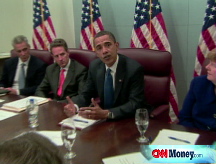Restarting the frozen loans market
Small business loan volume has plummeted, thanks in part to the collapse of the secondary market for such loans. Here's what the Fed plans to do about it.
 |
| Dennis and Lisa Morton, pictured with their children, were closing in on negotiations for a loan to open a CiCi's franchise. When they couldn't land the loan, their business plans went into limbo. |
(CNNMoney.com) -- The government's first step toward thawing the frozen market for small business loans will take effect next month, in a behind-the-scenes move to unlock the capital some banks rely on to finance their small business lending.
The Federal Reserve Bank of New York announced in late November an initiative called TALF, an acronym for Term Asset-Backed Securities Loan Facility. The program will make up to $200 billion in government money available for loans to investors that purchase bundles of bank loans, called "asset-backed securities" (ABS).
Many banks that make car loans, mortgage loans and small business loans bundle those loans up into ABS packages and sell them on to investors. Those sales provide the banks with the capital to make more loans. The Small Business Administration estimates that half of the banks that make SBA-guaranteed small business loans then resell the loans. But the ABS market abruptly dried up in September and October as the financial crisis spread.
Unable to resell their loans, banks that relied on this secondary market pulled back on their lending. That left potential borrowers like Lisa and Dennis Morton stranded.
The Mortons worked for months to line up the financing to get their business off the ground. After Dennis was laid off from a corporate job in February, the Mortons decided to pursue their longtime dream of opening a CiCi's restaurant in their neighborhood, south of Chicago. Dennis underwent training in Texas, where the franchise is headquartered, began making arrangements in June for a business loan from lending company CIT Group (CIT, Fortune 500), and started lease negotiations for a building the couple loved.
"We paid franchise fees, deposits for lawyers and architects, and paid for the furniture," Lisa Morton said. "We had already invested $50,000 of our own savings by early October, when we were ready to move forward with the loan. It was then that we received an e-mail from CIT stating that the loan had fallen through."
Experts say many lending lines disappeared when the ABS market collapsed.
"For any bank dependent on the secondary market, they are finished," said Tony Wilkinson, president and CEO of the National Association of Government Guaranteed Lenders (NAGGL), a trade group that serves SBA lenders. "If they can't sell the loans, they can't do the next loan."
Since losing their CIT deal, the Mortons have contacted 25 banks. But without any bites, they have lost the location they were hoping to lease.
TALF, which begins lending in February, is intended to restart the secondary loan market, but experts say most loan seekers won't see any immediate relief. In order to ensure that its $200 billion is used to invest in stable loans, the Fed is allowing TALF money to be used only for top-rated securities. For small business loans, that means the money can only be used to buy SBA-backed loans, and cannot be used for small business loans made privately by banks.
"TALF money will only go to brand-new loans [and new loan pools]. This it not really a bailout for problem businesses - just a program to spur the economy," said Joel Pruis, director of advisory services for Baker Hill, a financial consultancy branch of Experian that advises SBA bank lenders.
SBA loans make up only a small fraction of the total small-business lending landscape, and their numbers are declining. The agency's flagship 7(a) program backed 69,434 loans in 2008, 30% fewer than it did in 2007.
But if the secondary market remains dormant, SBA loans will grow even scarcer. Of the $12.67 billion in loans made through the 7(a) program last year, $4.1 billion in loans were resold to investors, according to SBA data. In last three months of 2008, the 7(a) program backed 57% fewer loans than it did a year earlier, a decline the SBA attributes in part to the secondary market's collapse in September.
"We've been having conversations with the Fed throughout the secondary market situation to show how critical [the market] is for us, and to find liquidity for it," said Grady Hedgespeth, the SBA's director of financial assistance. "When they announced TALF, it was just what we had hoped for. We're extremely hopeful that TALF will loosen the $2 to $3 billion that is stuck in the broker-dealer network without a buyer."
SBA lenders that depend on the secondary market said the program could have demonstrable effects on small business lending.
"Up to now the situation has been okay for us because we have liquidity, but if the secondary market continues as it has, we may have liquidity issues in coming months," said Young Ho Won, senior executive vice president of Innovative Bank in Oakland. Innovative Bank made more SBA loans last year than any other bank except JPMorgan Chase.
"The TALF program will be very helpful to SBA lenders, as it will naturally increase loans," Won said.
Temecula Valley Bancorp (TMCV), another top SBA lending institution in Temecula, Calif., is turning away applications for SBA loans until the secondary market opens up.
"We are completely behind it and supportive," said Tamecula's CEO Frank Basirico. "We were originating so many SBA loans in 2008, but the driver for those loans was the liquidity we got from selling them. TALF should stimulate that action again."
But if the government really wants to jump-start the small-business financing market, it will need to take broader action. While economic conditions have contributed to the sharp drop in SBA lending, critics say the SBA's program has other flaws, including high participation costs for both banks and borrowers.
"Businesses need TALF to kick in," said NAGGL's Wilkinson. "But the SBA needs to come up with enhancements to make it really work."
"The SBA has made improvements in the last ten years to be an attractive method for financing, but it's still a cumbersome process," said Baker Hill's Prius. He recommends that the SBA streamline the process so that SBA loans are easier and less expensive for banks to manage.
On the campaign trail, President-elect Obama called for the SBA to temporarily eliminate fees for its 7(a) and 504 loan-guarantee programs. Several senators, including John Kerry and Chuck Schumer, have issued similar proposals.
The SBA caps the interest rates banks can charge for loans made through its guarantee programs. Wilkinson's trade group would like to see the SBA lift those caps, a move he thinks would spur more lending. Right now, it's often more profitable for banks to avoid the SBA's programs and make private small business loans.
"I believe small businesses will be willing to pay more, so long as they can just get the money," Wilkinson said.
The Mortons certainly would. Unable to get any kind of business loan, from any bank, Dennis Morton is now looking for a job, while his family's CiCi's venture remains stuck in limbo. Their time is running out.
"Our plan was to be under construction now and then open by March 1. Clearly, that's not going to happen," said Lisa Morton. "We're now starting to live off of the money we had saved for our down payment, so even if something does happen, we won't have the 20% we need to start the business." ![]()
Sharp drop in small business loans
2009: The forecast for entrepreneurs
Victims of the crash: 7 brands that died
Message to Obama: Send loans fast
-
The Cheesecake Factory created smaller portions to survive the downturn. Play
-
A breeder of award-winning marijuana seeds is following the money and heading to the U.S. More
-
Most small businesses die within five years, but Amish businesses have a survival rate north of 90%. More
-
The 10 most popular franchise brands over the past decade -- and their failure rates. More
-
These firms are the last left in America making iconic products now in their twilight. More












